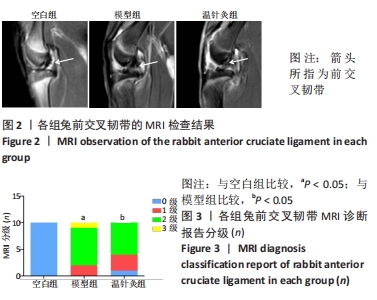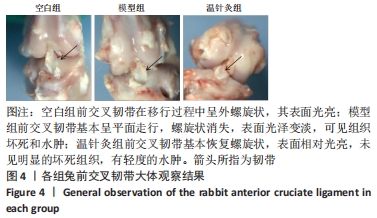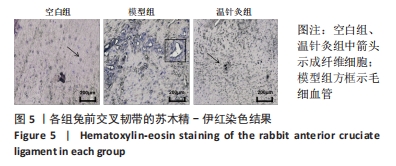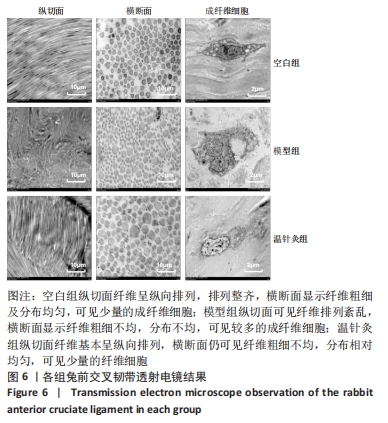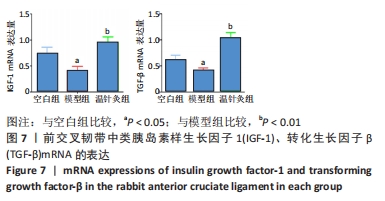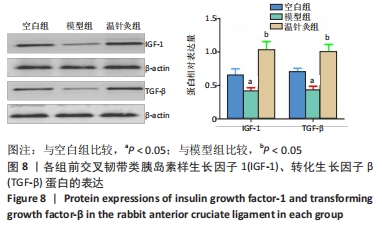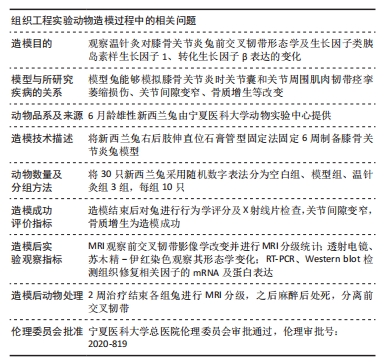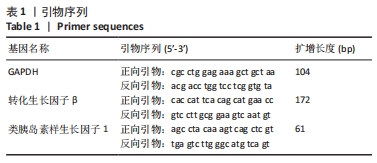中国组织工程研究 ›› 2024, Vol. 28 ›› Issue (23): 3621-3626.doi: 10.12307/2024.415
• 肌肉肌腱韧带组织构建 tissue construction of the muscle, tendon and ligament • 上一篇 下一篇
温针灸对膝骨关节炎兔损伤前交叉韧带修复及相关因子的影响
李 春1,张艳玲1,刘 娣1,王明磊1,王 铎2,刘君伟1,武永利1,3
- 1宁夏医科大学总医院,宁夏回族自治区银川市 750004;2灵武市中医院,宁夏回族自治区灵武市 751600;3宁夏少数民族医药现代化教育部重点实验室,宁夏回族自治区银川市 750004
Effect of warm-needling moxibustion on anterior cruciate ligament injury repair and related growth factors in rabbits with knee osteoarthritis
Li Chun1, Zhang Yanlin1, Liu Di1, Wang Minglei1, Wang Duo2, Liu Junwei1, Wu Yongli1, 3
- 1General Hospital of Ningxia Medical University, Yinchuan 750004, Ningxia Hui Autonomous Region, China; 2Lingwu Traditional Chinese Medicine Hospital, Lingwu 751600, Ningxia Hui Autonomous Region, China; 3Key Laboratory of Ningxia Ethomedicine Modernization, Ministry of Education, Ningxia Medical University, Yinchuan 750004, Ningxia Hui Autonomous Region, China
摘要:
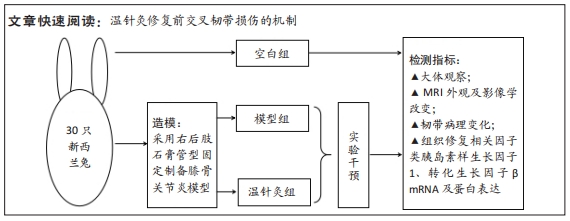
文题释义:
温针灸:是中医外治法之一,一种将针刺与艾灸相结合的疗法,在针刺得气后将艾柱插入针柄上点燃,借助针体将热力传入穴位。该法具有温经通络、消肿止痛的功效,可改善病变部位的气血运行,起到抗炎、消肿、镇痛的作用,为临床治疗膝骨关节炎常用方法。类胰岛素样生长因子(insulin-like growth factor-1,IGF-1):能显著促进前交叉韧带成纤维细胞的DNA及胞外基质的合成,其增加可显著增加胶原含量,恢复韧带组织结构。
转化生长因子β(transforming growth factor β,TGF-β):对于创伤修复与胶原合成具有显著的促进作用,并且可以增加损伤前交叉韧带成纤维细胞中赖氨酰氧化酶的表达,进一步促进细胞外基质中胶原的交联,从而修复韧带损伤。
背景:温针灸可有效治疗膝骨关节炎。前交叉韧带的退变、损伤、断裂可影响膝关节局部稳定性,进而诱发膝骨关节炎的形成,温针灸是否可修复损伤前交叉韧带及其作用机制,目前尚不清楚。
目的:观察温针灸对膝骨关节炎兔前交叉韧带形态学及相关生长因子类胰岛素样生长因子1、转化生长因子β表达的变化,明确温针灸修复前交叉韧带的作用机制。方法:将30只新西兰兔采用随机数字表法分为空白组、模型组、温针灸组3组,每组10只。模型组和温针灸组兔采用石膏管型固定法制备膝骨关节炎兔模型。造模成功后,模型组每日于兔固定架固定15 min;温针灸组选取“鹤顶”“内膝眼”“外膝眼”行温针灸治疗,每日1次,7日为1个疗程,共治疗2个疗程;空白组不予干预。治疗结束后MRI观察前交叉韧带影像学改变,并进行MRI分级统计;透射电镜、苏木精-伊红染色观察其形态学变化;RT-PCR、Western blot检测组织类胰岛素样生长因子1、转化生长因子β mRNA及蛋白的表达。
结果与结论:①MRI检查:与空白组比较,模型组前交叉韧带增粗、水肿、部分撕裂,分级评估差异有统计学意义(P < 0.05);与模型组比较,温针灸组韧带增粗略轻,轻度水肿,无撕裂,分级评估差异有统计学意义(P < 0.05)。②大体观察:模型组前交叉韧带表面光泽变淡,边侧有絮状被膜覆盖,有明显组织坏死;温针灸组韧带表面光泽,韧带呈正常螺旋走形。③苏木精-伊红染色:模型组前交叉韧带内明显组织坏死,大量新生毛细血管,成纤维细胞及胶原纤维排列松散;温针灸组韧带内有少量组织坏死,偶见新生血管,细胞及胶原纤维排列疏松、欠规则。④透射电镜观察:模型组前交叉韧带纤维排列紊乱,粗细不均,分布不均,成纤维细胞较多且形态不规则;温针灸组纤维基本呈纵向排列,纤维粗细、分布不均,少量椭圆形的纤维细胞存在。⑤RT-PCR和Western blot结果:与空白组比较,模型组类胰岛素样生长因子1、转化生长因子β mRNA及蛋白表达明显降低(均P < 0.05);温针灸组上述2项指标表达明显升高(均P < 0.05)。⑥结果说明,温针灸可改善前交叉韧带的损伤,可能通过调控类胰岛素样生长因子1、转化生长因子β的表达治疗膝骨关节炎。
https://orcid.org/0009-0002-2319-5800(李春)
中国组织工程研究杂志出版内容重点:组织构建;骨细胞;软骨细胞;细胞培养;成纤维细胞;血管内皮细胞;骨质疏松;组织工程
中图分类号:
